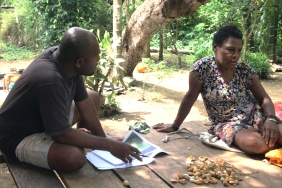MINI SYMPOSIUM ON WATER AREA MANAGEMENT
Although Indonesian waters are rich in diverse and abundant fish, in fact many coastal villages still have a high level of poverty, for example in Papua. Dr. Fitryanti Pakiding from Papua State University in her presentation "The paradox of poverty and abundance of fisheries resources: The story of coastal communities in the BHS MPA, Papua" explained that Tanah Papua has more than 1700 species of reef fish, healthy fish stocks, and is the center of coral diversity in the world, but is the poorest province in Indonesia. One of the reasons is that the community is too dependent on fisheries resources and fisheries management in the area is not maximized. Without good management, Indonesia's fisheries could collapse due to overexploitation and damage, as has happened in many places in Indonesia.
The same thing was also presented by 17 other presenters who attended the mini-symposium on Marine Protected Area Management for Sustainable Fisheries at the JW Marriot Hotel Surabaya on Friday (21/11). Presenters consisting of academics and conservation activists from Jakarta, Papua, Ambon, Kupang, Wakatobi, Makassar, Manado, Palembang, East Java, and Bogor had the opportunity to share their experiences in carrying out activities and research related to sustainable fisheries in marine protected areas (MPAs).
The event, supported by WWF-Indonesia and the Directorate of Conservation Areas and Fish Species (KKJI), was one of the supporting activities at the IXth National Conference on Coastal, Marine and Small Island Resource Management organized by the Ministry of Maritime Affairs and Fisheries. By bringing together case studies and research related to fisheries and marine area management, lessons learned and recommendations were developed to help stakeholders design and manage MPAs to build fish stocks and provide sustainable economic benefits to local communities in Indonesia.
Based on the results of the discussion, with a total of 145 MPAs spread from Sabang to Merauke with a total area of 16.5 million hectares, the integration of sustainable fisheries concepts into marine protected areas is the right step as a way to increase the availability of fish stocks and support the local economy. MPA management is not only about protection and conservation, but also emphasizes the importance of utilizing the area to support the welfare of the community. This utilization includes the use of capture fisheries and aquaculture, tourism, research & development and other economic activities that support conservation. MPAs function in reducing the negative impacts of fisheries activities and regulating utilization through the regulation of fishing gear, number of fishermen, types of vessels, etc.
Dr. Lida Pet-Soede from WWF-Indonesia shared her experience through her presentation "The Relevance of Designing MPAs for Fish Fillets" on small-scale fisheries recovery efforts in the Koon Islands in East Seram Regency and Wakatobi National Park. The case study describes sustainable fisheries management through a zoning system in MPAs to restore fisheries stocks and ensure food security for local communities. The core zones implemented in the two conservation areas serve as fish protection areas, especially spawning grounds. The benefits that can be obtained are that it provides an opportunity for an increased number of fish to grow and reproduce, which in turn will increase the amount of catch in the surrounding area.
In addition to implementing a zoning system in MPAs, the involvement of fishing communities plays a key role in managing the fisheries resources on which they depend, both for food security and as a source of livelihood. Milawati Ode from the Wakatobi Regency Marine and Fisheries Office shared her experience in trying to increase community knowledge about the role, benefits and rules through a conservation program that focuses on the human aspect through behavior change.
A collaborative management approach is the key to the success of effective MPA management and sustainable funding, where the roles, responsibilities and benefits can be felt by all parties, especially in the fisheries sector. The learnings and experiences of the presenters presented in this mini-symposium were also discussed with more than 20 other participants from students, academics, government and environmental and fisheries practitioners.





